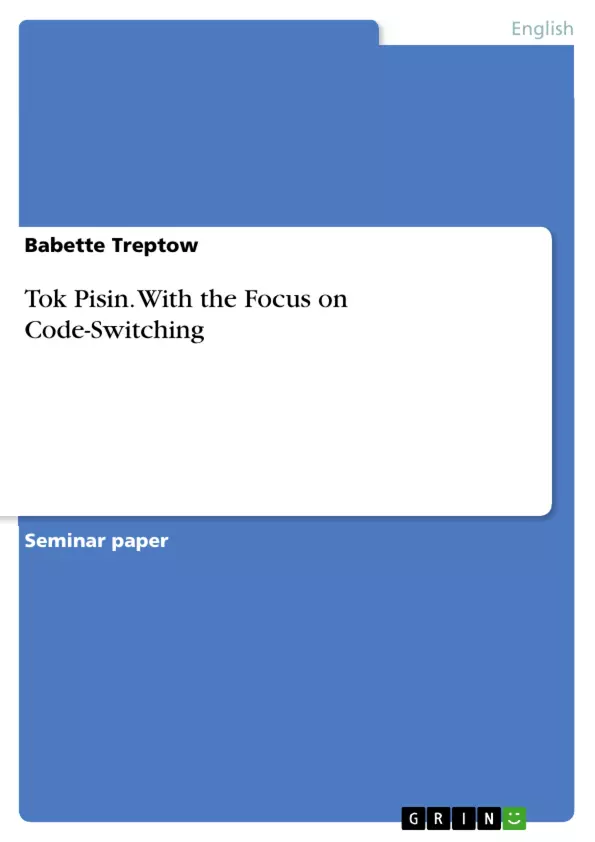Pidgin and creole languages, once described as “broken English”, “bastardized jargons” or “marginal languages”, became objects of serious research for many professional linguists from all over the world. They have generally been accepted as new and independent languages rather than corrupted versions of other, so-called higher, languages (cf. Holm 2000:1). Pidgins and creoles became central to linguistic studies on first and second language acquisition, language linguistic universals, language change and language contact (cf. Todd 2001: 524). McMahon (1994: 253) points out that there are “[a]pproximately 200 pidgin and creole languages spoken today, mostly in West Africa, the Carribean and the South Pacific.” Tok Pisin, a national language of Papua New Guinea, which is located in the southwest of the Pacific Ocean, can be considered a pidgin/creole language1. In many respects, it shares the linguistic and socio-historical features of other pidgins and creoles spoken around the world. However, Tok Pisin is unusual with regard to its linguistic development, which did not take as much time as in the case of most other pidgin and creole languages. Moreover, linguists are eagerly interested in studying this contact language because its historical development is precisely and accurately documented (cf. Mühlhäusler 1990: 177-181).
The pidgin language Tok Pisin has been introduced in the course of this semester´s seminar Contact Situations: English-Related Pidgins and Creoles. I was part of the presentation group on Tok Pisin. Already then, my interest was raised. Thus, I was concerned with literature and information about the pidgin language before I began to write this term paper.
This term paper raises the question whether and to what extent Tok Pisin gains influence in Papua New Guinea over the course of time? In this context, various evidence for the assumption will be displayed and above this, several reasons for the spreading of the language will be depicted. For this purpose, I will make use of a variety of scholarly literature, whereby I will especially focus on well-known linguists, such as Mühlhäusler, Holm or Kulick et al..
Inhaltsverzeichnis (Table of Contents)
- Introduction
- General Background Information
- Pidgins and Creoles
- Tok Pisin
- Tok Pisin - Historical Background
- Current Status of Tok Pisin
- Code-Switching in Gapun
- Gapun and its Sociolinguistic Situation
- Code-Switching versus Borrowing
- Everyday Language Use in Gapun
- Conclusion
Zielsetzung und Themenschwerpunkte (Objectives and Key Themes)
This term paper aims to explore the influence of Tok Pisin, a pidgin language spoken in Papua New Guinea, over time. The paper examines various pieces of evidence that support this influence, including reasons for the language's spread. It analyzes how Tok Pisin affects language use within the Gapun community, highlighting the village's sociolinguistic situation and the use of code-switching between Tok Pisin and the indigenous language.
- The historical development and current status of Tok Pisin.
- The impact of Tok Pisin on language use in Gapun.
- The distinction between code-switching and borrowing.
- The functions of code-switching in the Gapun community.
- The influence of Tok Pisin on the linguistic landscape of Papua New Guinea.
Zusammenfassung der Kapitel (Chapter Summaries)
- Introduction: Introduces the topic of Tok Pisin and its significance as a pidgin/creole language. It outlines the research question concerning the influence of Tok Pisin in Papua New Guinea, referencing relevant scholarship.
- General Background Information: Provides a definition of pidgins and creoles, outlining key characteristics and distinctions. It then focuses on Tok Pisin, describing its historical development and current status within Papua New Guinea.
- Code-Switching in Gapun: Introduces the village of Gapun and its sociolinguistic situation. It defines code-switching and contrasts it with borrowing, exploring the everyday language use in Gapun, where villagers code-switch between Tok Pisin and their indigenous language.
Schlüsselwörter (Keywords)
The paper focuses on Tok Pisin, a pidgin/creole language, its historical development, its current status in Papua New Guinea, and the use of code-switching in the Gapun community. It explores the sociolinguistic context of language use, including the distinction between code-switching and borrowing, and the functions of code-switching. The study is based on research by notable linguists such as Mühlhäusler, Holm, and Kulick, highlighting the significance of this contact language in understanding linguistic change and language contact phenomena.
- Quote paper
- Babette Treptow (Author), 2010, Tok Pisin. With the Focus on Code-Switching, Munich, GRIN Verlag, https://www.grin.com/document/154308



